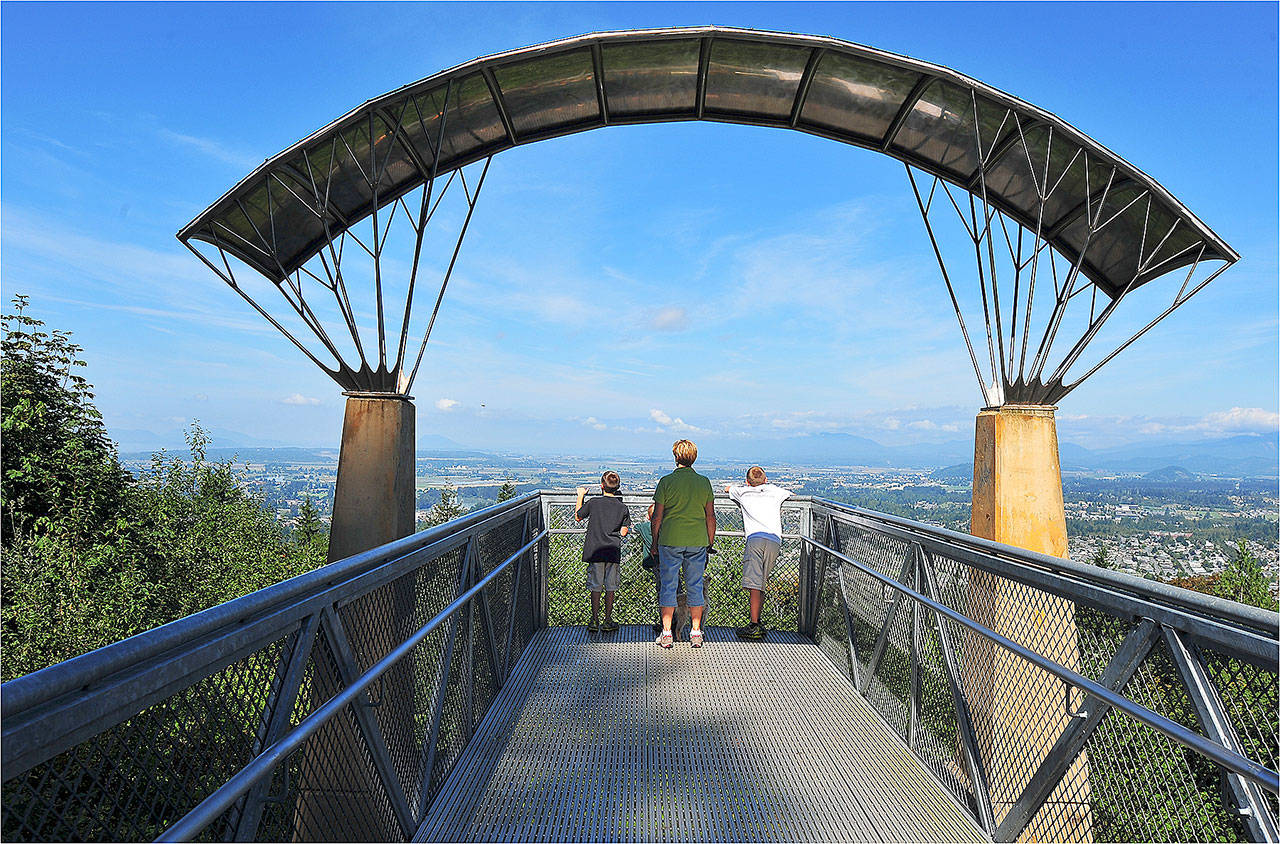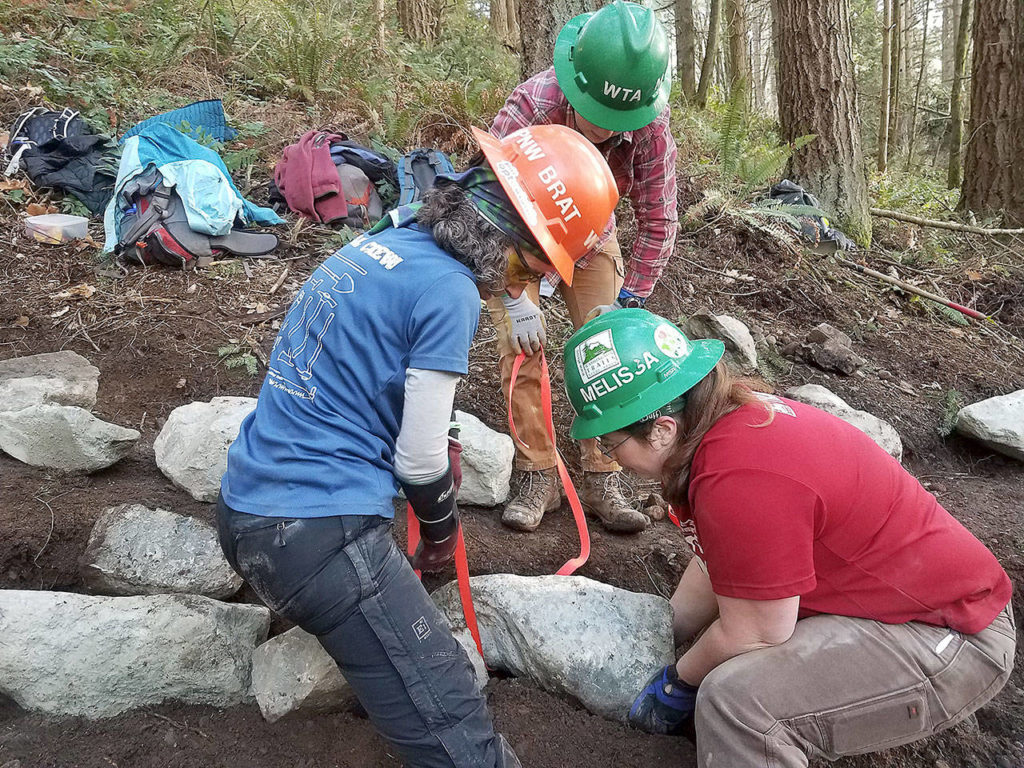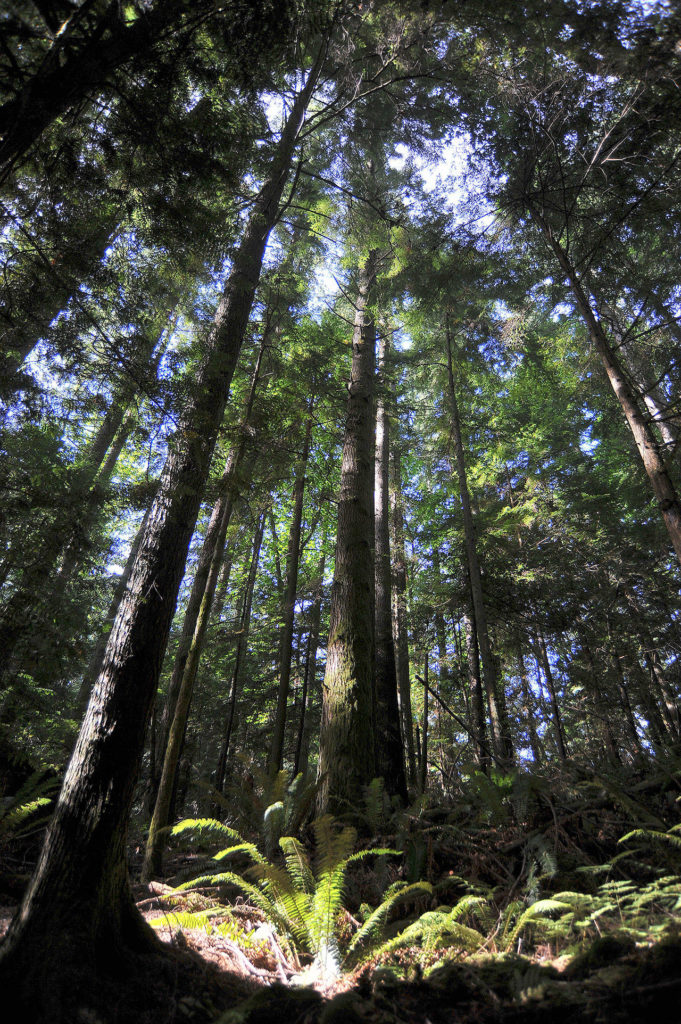By Anna Roth / Washington Trails Association
MOUNT VERNON — Plenty of parks and green spaces are interspersed in and around cities in Washington, but few hit the combination of variety and accessibility found at Little Mountain Park. Here, in this 500-acre park, you can enjoy a day outside entirely on foot or on bike, just five minutes from downtown Mount Vernon.
It’s one of the easiest-to-access trail systems in the state, whether hikers or bikers they want a steep calf-burner, or a longer, gentler route to the top. And that’s thanks to work done by Washington Trails Association staff and volunteers in partnership with Skagit Land Trust and Mount Vernon Parks and Recreation.
Creative solutions to improve a trail network
For two years, WTA has been improving the Darvill Trail, built by the late Fred Darvill, a local who purchased a parcel of land adjacent to Little Mountain Park to keep it from being developed. A climber, Darvill wanted to be able to walk from his house to the nearby mountain to get some training in, so he built his namesake trail to get to Little Mountain Park.
Now owned by his widow, Ginny Darvill, the property is in trust with Skagit Land Trust. Mount Vernon city government has an easement on the property, which allows the city (or any partner it contracts with) to maintain the trail.
Enter WTA. Two years ago, the city of Mount Vernon contracted us to help improve the Darvill Trail. The water table had risen since Fred Darvill built it, and sections of the route were practically under water during the wet season.
“We were up to mid-calf in mud,” recalled Barbara Budd, the crew leader on those work parties. “It was so wet there that our usual solutions wouldn’t work. We wound up build a new sort of structure for me — a puncheon.”
A puncheon is a low-level boardwalk-like structure typically used to span a wet or boggy area on trail. They differ from bridges primarily in how they are constructed, and how high off the ground they rise. A bridge can soar many feet into the air, while a puncheon usually squats no more than a few inches to 2 feet off the ground.
But first the crew had to sink gravel and cement blocks into the muck to have a foundation on which to build.
Budd, who worked for the Forest Service before she joined WTA, had never made a puncheon before. She was thrilled for the opportunity to learn on trail.
“It was a new experience for me, so it was fun to learn something new in the field.”
Partnerships build trust, WTA builds trails
Once the city saw the quality of the work WTA had done on the Darvill Trail, they asked us to help out on other projects. Fred Darvill had also built a trail he dubbed Up Quick, which does just that; gets hikers up to the top — quick.
“Fred built it as a training trail, but it was starting to see a wider variety of users. More people were slipping and falling because of the steepness and there were erosion concerns,” Budd said.
So she and Arlen Bogaards, WTA’s northwest regional manager, scouted a new, more sustainable route for Up Quick. This meant changing it from a fall line trail (meaning one going straight up the hill) to a longer one with more switchbacks.
They put in a rough line and our contacts at the city of Mount Vernon came in to approve it. Budd and Bogaards saw the new route as an opportunity to host a “Trail Layout and Design” class for WTA assistant crew leaders. This class flagged the route, so that future crews could come in and get to building it.
It’s still a good trainer — and the route is more sustainable than one heading straight uphill would be.
Mentorship and growth on trail
Little Mountain Park was also the site of several of WTA’s first all-women work parties. Crews got the opportunity to try very technical skills, since the project on the Darvill Trail involved building puncheons and stairs, and the work on Up Quick required lots of rock and tread work.
Karen Bean, a new assistant crew leader, credits the work parties on Little Mountain Park with helping her become a leader in the trail maintenance community.
“These all-women parties were the first times I was able to teach people new skills and it felt really good. It helped build my confidence, and gave me a purpose. I really wanted to keep empowering people, especially women, and give them the sense of fulfillment that I get when I work on trails.”
A volunteer wrote: “Appreciated the positive environment that was created by our crew leaders. Love that there are women-only groups!”
And Budd loves leading these work parties. “I have a passion for encouraging women to spend their time outdoors doing things that society tells us we can’t.”
Passing hikers, who saw the work being done, have been inspired to join future work parties. Even Ginny Darvill herself has helped out on several of them.
“Ginny is a delight and a half,” Budd said. “She joins our work parties fairly regularly and is out there digging in the dirt with the rest of us. She loves it. She makes us homemade cookies for every work party she comes to, and let us sit in her garage during lunch to avoid the rain.”
Trees
Building for the future
Little Mountain Park already is a local haven for the community to connect with the outdoors. One of WTA’s youth ambassadors took a class of fourth- and fifth-graders here to spend some time outside and wrote a trip report about the experience.
Mount Vernon Elementary School fifth-graders also use the trails on Little Mountain Park to connect with nature in their back yard. A Mount Vernon local also is exploring these trails one at a time with his toddler.
Trails serve communities best when they stand the test of time. And it takes a lot of work and investment from many partners to make sure they’re sustainable.
One volunteer summed up just how much work it can take to create a long-lasting trail: “It was a day of learning that we needed to square everything and level it out within an ant’s eyelash or the whole project goes sideways at the end.”
“We hauled gravel, shoveled muck, sawed, drilled and pounded and, as it was time to go, we were screwing the last screws in on our bridging material. When this trail is finished, it will make an excellent addition to the trails in this nice little park. We hikers owe a debt of gratitude to the family who deeded this property to prevent it from becoming suburban sprawl instead of a nice little winter hiking spot.”
Washington Trails Association promotes hiking as a way to inspire a people to protect Washington’s natural places. Get inspired to go hiking and learn how you can help protect trails at www.wta.org.
If you go
Little Mountain Park, 300 Little Mountain Road, just south of Mount Vernon, is open 10 a.m. to 8 p.m. daily. Follow the 1.5 mile road to the top of Little Mountain, an elevation gain of 934 feet. A covered viewpoint provides a spectacular look at the Skagit Valley, San Juan Islands and the Olympic Mountains. Call 360-336-6215 or go to www.littlemountainpark.org for more information.
> Give us your news tips. > Send us a letter to the editor. > More Herald contact information.Talk to us
Gallery



























